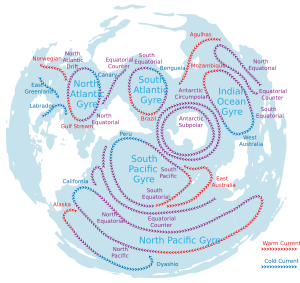Ocean gyre facts for kids
A gyre is like a giant, swirling system of ocean currents. Imagine a huge whirlpool in the ocean! These massive swirls are caused by something called the Coriolis effect. Because our Earth is always spinning, ocean currents in the northern hemisphere (the top half of the Earth) tend to move in a clockwise direction. In the southern hemisphere (the bottom half), they spin the other way, anti-clockwise.
The Coriolis effect is strongest on the wind. Then, the wind helps create a twisting force, like a torque, that makes the ocean currents spin. The Earth spins from west to east. This makes the Coriolis effect stronger closer to the poles. Because of this, gyres create very strong currents on the western side of oceans. These currents get pushed against the eastern coasts of continents.
The word gyre can mean any kind of vortex (a spinning mass) in the air or the sea. But it's mostly used in oceanography to talk about these huge ocean current systems.
Contents
Major Ocean Gyres
There are five really big gyres in the world's oceans:
- Indian Ocean Gyre
- North Atlantic Gyre
- North Pacific Gyre
- South Atlantic Gyre
- South Pacific Gyre
Different Kinds of Gyres
Tropical Gyres
Tropical gyres are found near the Earth's equator. They mostly stretch from east to west, with only a small north-south movement.
- Atlantic Equatorial Current System
- Pacific Equatorial Current System
- Indian Monsoon Gyres
Subtropical Gyres
The middle of a subtropical gyre is a high pressure area. The ocean currents move around this high-pressure center. This high pressure happens because of the winds. Westerly winds on the northern side and easterly winds on the southern side push surface currents towards the center of the gyre.
Subpolar Gyres
Subpolar gyres form in very cold areas, close to the poles (around 60° latitude). Here, the ocean currents spin around a low pressure area. The surface currents in these gyres usually move outwards from the center.
Related Topics
- Cyclone and Anticyclone (These are similar spinning systems in the air!)
- Fluid dynamics (The study of how liquids and gases move)
- Great Pacific Garbage Patch (A huge area in the ocean where trash collects, often due to gyres)
- Whirlpool
Images for kids
See also
 In Spanish: Giro oceánico para niños
In Spanish: Giro oceánico para niños




